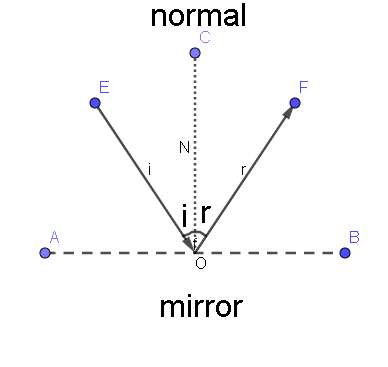
Explain the nature of the image formed by the plane mirror.
Answer
495.6k+ views
Hint: The mirrors that have a flat reflecting surface are called plane mirrors. As we know light always reflects in a regular manner for a plane surface. We need to know certain rules to understand image formation by a plane mirror.
Complete answer:
Mirrors are a part of our daily lives. Is there any day you don’t look into the mirror? I doubt that very few answers would be no. But do you know how this image is formed? Well lets see how:
First thing to know is that images formed in the plane mirror are the same size as the object. The light ray coming from the object hits the plane mirror and reflects the ray back that forms an image. Now to have a better idea, let's learn the laws of reflection.
There are 2 laws of reflection:
1. The $1^{st}$ law states that the angle of the incident ray is equal to the angle of the reflected ray.
2. The normal, incident ray and reflected ray all lie in the same plane.
Look at the image below to get a better idea.

To understand how reflection is seen by us ,look at the following image:

We see 2 rays emerging from the object , one from P and another from P’. They strike the mirror and reflect to our eyes . Here the law of reflection is applied to the trace path of the reflected ray. And if we further extend the rays backwards we see that the rays seem to originate from points Q and Q’. Thus if we go on making many such rays from the object we will see that the height of the object is equal to the height of the image.
And this is how image formation by a plane mirror takes place.
Note: Do not confuse between reflection and refraction. Laws are different for both cases. And also
Remember these points for convenience. The characteristic features of plane mirror are as follows:
The image formed is virtual and erect.
Image formed is equal to the size of the object.
Distance between object and mirror= distance between image and mirror
Image formed is behind the mirror.
Complete answer:
Mirrors are a part of our daily lives. Is there any day you don’t look into the mirror? I doubt that very few answers would be no. But do you know how this image is formed? Well lets see how:
First thing to know is that images formed in the plane mirror are the same size as the object. The light ray coming from the object hits the plane mirror and reflects the ray back that forms an image. Now to have a better idea, let's learn the laws of reflection.
There are 2 laws of reflection:
1. The $1^{st}$ law states that the angle of the incident ray is equal to the angle of the reflected ray.
2. The normal, incident ray and reflected ray all lie in the same plane.
Look at the image below to get a better idea.

To understand how reflection is seen by us ,look at the following image:

We see 2 rays emerging from the object , one from P and another from P’. They strike the mirror and reflect to our eyes . Here the law of reflection is applied to the trace path of the reflected ray. And if we further extend the rays backwards we see that the rays seem to originate from points Q and Q’. Thus if we go on making many such rays from the object we will see that the height of the object is equal to the height of the image.
And this is how image formation by a plane mirror takes place.
Note: Do not confuse between reflection and refraction. Laws are different for both cases. And also
Remember these points for convenience. The characteristic features of plane mirror are as follows:
The image formed is virtual and erect.
Image formed is equal to the size of the object.
Distance between object and mirror= distance between image and mirror
Image formed is behind the mirror.
Recently Updated Pages
A man running at a speed 5 ms is viewed in the side class 12 physics CBSE

The number of solutions in x in 02pi for which sqrt class 12 maths CBSE

State and explain Hardy Weinbergs Principle class 12 biology CBSE

Write any two methods of preparation of phenol Give class 12 chemistry CBSE

Which of the following statements is wrong a Amnion class 12 biology CBSE

Differentiate between action potential and resting class 12 biology CBSE

Trending doubts
What are the major means of transport Explain each class 12 social science CBSE

Differentiate between homogeneous and heterogeneous class 12 chemistry CBSE

What is virtual and erect image ?

What is the Full Form of PVC, PET, HDPE, LDPE, PP and PS ?

The first microscope was invented by A Leeuwenhoek class 12 biology CBSE

Write any three uses of polaroids class 12 physics CBSE




